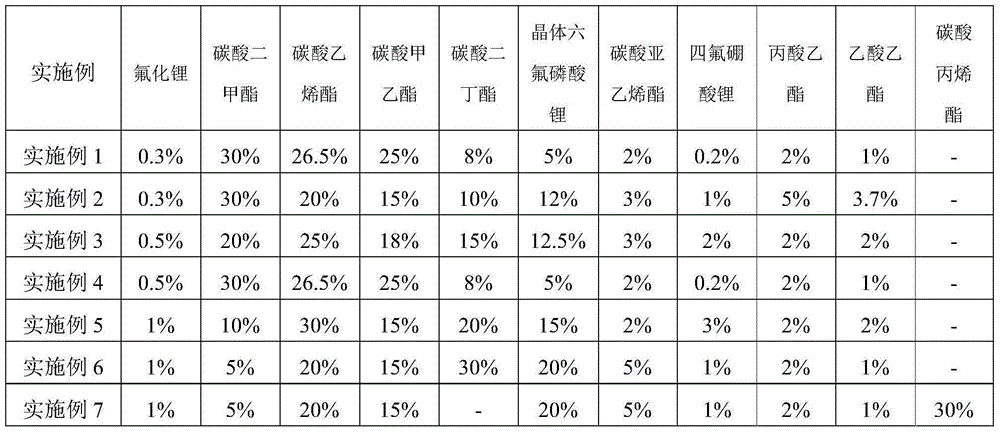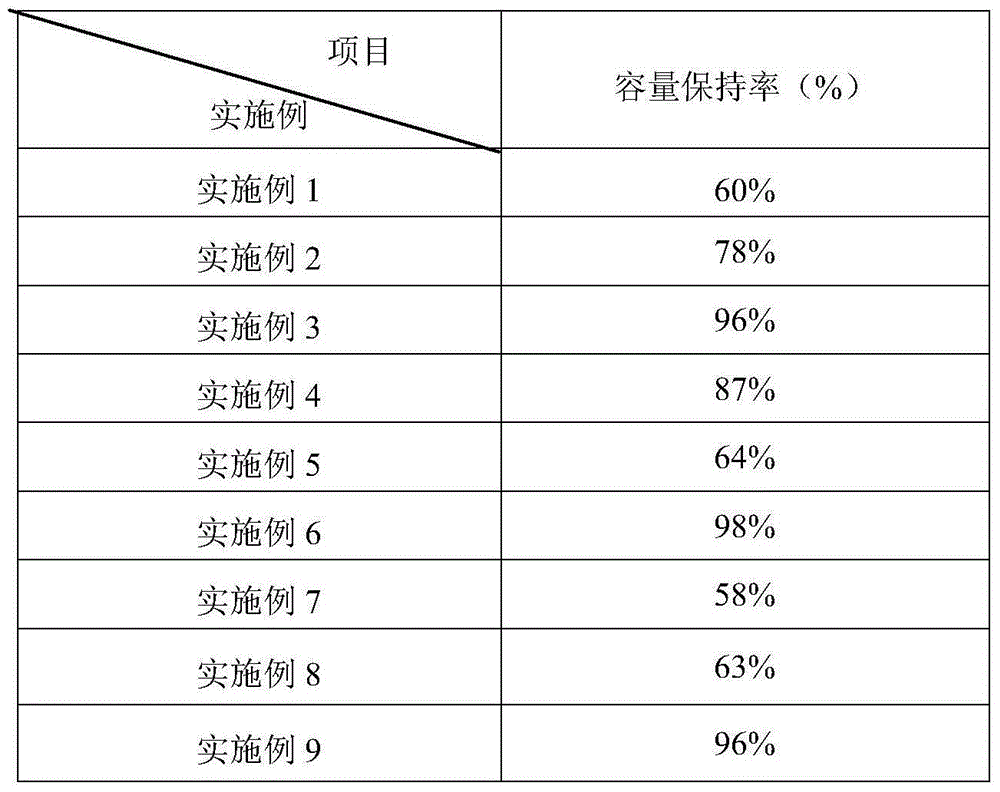Lithium ion battery low temperature electrolyte and lithium ion battery
A lithium-ion battery and electrolyte technology, applied in the field of lithium-ion batteries, can solve problems such as poor discharge performance and achieve the effect of improving low-temperature performance
- Summary
- Abstract
- Description
- Claims
- Application Information
AI Technical Summary
Problems solved by technology
Method used
Image
Examples
Embodiment 1
[0017] The lithium-ion battery low-temperature electrolyte of this embodiment is composed of the following components in weight percent: lithium hexafluorophosphate 5%, lithium fluoride 0.3%, lithium tetrafluoroborate 0.2%, dimethyl carbonate 30%, ethylene carbonate 26.5%, 25% ethyl methyl carbonate, 8% dibutyl carbonate, 2% vinylene carbonate, 2% ethyl propionate, 1% ethyl acetate.
[0018] In a glove box filled with argon gas, the moisture content is controlled to be <0.1ppm, and the oxygen content is <0.1ppm, and the above-mentioned components are uniformly mixed in proportion to obtain a low-temperature electrolyte for lithium-ion batteries.
[0019] The lithium-ion battery of this embodiment uses the ternary material as the positive electrode and artificial graphite as the negative electrode. The above-mentioned lithium-ion battery low-temperature electrolyte is injected into the battery system, and a lithium-ion battery with a battery capacity of 10Ah is prepared by using...
Embodiment 2
[0021] The lithium-ion battery low-temperature electrolyte of this embodiment is composed of the following components in weight percent: 12% lithium hexafluorophosphate, 0.3% lithium fluoride, 1% lithium tetrafluoroborate, 30% dimethyl carbonate, 20% ethylene carbonate, 15% ethyl methyl carbonate, 10% dibutyl carbonate, 3% vinylene carbonate, 5% ethyl propionate, 3.7% ethyl acetate.
[0022] In a glove box filled with argon gas, the moisture content is controlled to be <0.1ppm, and the oxygen content is <0.1ppm, and the above-mentioned components are uniformly mixed in proportion to obtain a low-temperature electrolyte for lithium-ion batteries.
[0023] In the lithium-ion battery of this embodiment, the ternary material is used as the positive electrode and the artificial graphite is used as the negative electrode. The above-mentioned lithium-ion battery low-temperature electrolyte is injected into the battery system, and a lithium-ion battery with a battery capacity of 10Ah i...
Embodiment 3
[0025] The lithium-ion battery low-temperature electrolyte of the present embodiment is composed of the following components in weight percent: 12.5% lithium hexafluorophosphate, 0.5% lithium fluoride, 2% lithium tetrafluoroborate, 20% dimethyl carbonate, 25% ethylene carbonate, 18% ethyl methyl carbonate, 15% dibutyl carbonate, 3% vinylene carbonate, 2% ethyl propionate, 2% ethyl acetate.
[0026] In a glove box filled with argon gas, the moisture content is controlled to be <0.1ppm, and the oxygen content is <0.1ppm, and the above-mentioned components are uniformly mixed in proportion to obtain a low-temperature electrolyte for lithium-ion batteries.
[0027] In the lithium-ion battery of this embodiment, the ternary material is used as the positive electrode and the artificial graphite is used as the negative electrode. The above-mentioned lithium-ion battery low-temperature electrolyte is injected into the battery system, and a lithium-ion battery with a battery capacity ...
PUM
 Login to View More
Login to View More Abstract
Description
Claims
Application Information
 Login to View More
Login to View More - R&D
- Intellectual Property
- Life Sciences
- Materials
- Tech Scout
- Unparalleled Data Quality
- Higher Quality Content
- 60% Fewer Hallucinations
Browse by: Latest US Patents, China's latest patents, Technical Efficacy Thesaurus, Application Domain, Technology Topic, Popular Technical Reports.
© 2025 PatSnap. All rights reserved.Legal|Privacy policy|Modern Slavery Act Transparency Statement|Sitemap|About US| Contact US: help@patsnap.com



